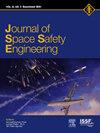Zero-G Lab: A multi-purpose facility for emulating space operations
Abstract
During orbital rendezvous, the spacecraft typically approach in the same orbital plane, and the phase of the orbit eventually aligns. Potential rendezvous and docking missions need to be emulated and tested in an on-ground facility for micro-gravity research prior to meeting the harsh conditions of space environment. For orbital docking, the velocity profile of the two spacecraft must be matched. The chaser is placed in a slightly lower orbit than the target. Since all these tasks are quite complex and the realization of space missions are very expensive, any space-related hardware or software’s performance must be tested in an on-ground facility providing zero gravity emulation before initiating its operation in space. This facility shall enable emulation conditions to mimic pseudo zero gravity. It is of critical importance to be equipped with all the necessary ”instruments and infrastructure” to test contact dynamics, guidance, navigation and control using robotic manipulators and/or floating platforms. The Zero-G Laboratory at the University of Luxembourg has been designed and built to emulate scenarios such as rendezvous, docking, capture and other interaction scenarios between separate spacecraft. It is equipped with relevant infrastructure including nearly space-representative lightning conditions, motion capture system, epoxy floor, mounted rails with robots, capability to integrate on-board computers and mount large mock-ups. These capabilities allow researchers to perform a wide variety of experiments for unique orbital scenarios. It gives a possibility to perform hybrid emulations with robots with integrated hardware adding pre-modeled software components. The entire facility can be commanded and operated in real-time and ensures the true nature of contact dynamics in space. The Zero-G Lab also brings great opportunities for companies/startups in the space industry to test their products before launching the space missions. The article provides a compilation of best practices, know-how and recommendations learned while constructing the facility. It is addressed to the research community to act as a guideline to construct a similar facility.

 求助内容:
求助内容: 应助结果提醒方式:
应助结果提醒方式:


